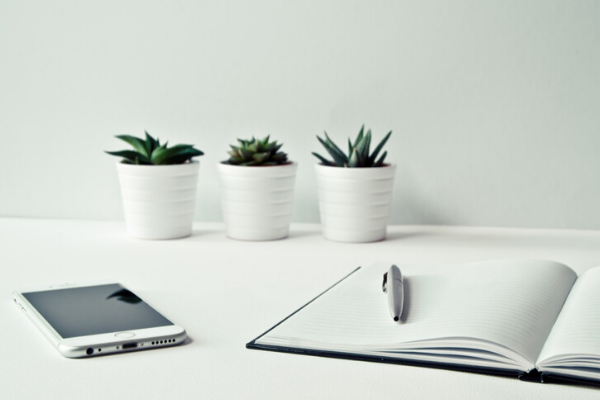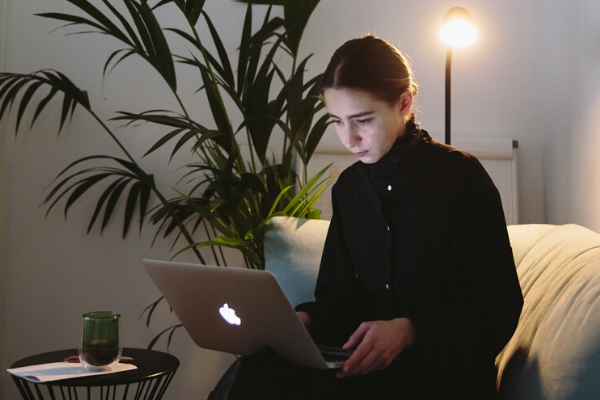11 Ways to Use Mindfulness At Work
Adopting mindfulness habits in the workplace can help reduce stress, enhance our communication skills and help us to manage our wellbeing better while at work.
Mindfulness is nothing new. In fact, it’s steeped in ancient eastern teachings, but over the past decade, it’s gradually grown in popularity here in the western world. This is for many reasons, our need for a better connection with each other, and our increase in cases of burnout and depression. But the fact is, there’s never been a more needed time for mindfulness than in our busy, hectic modern lives.
Living more mindfully provides many benefits, but it’s easy to forget that mindfulness techniques can be used in the workplace.
Maybe it’s because we continue to draw a line between work and life? – But the more you use mindfulness in the workplace, the more likely you are to live a happier and healthier life. After all, work affects life, and life affects work.
Whether you’re completely new to mindfulness or continuing to practice it in your everyday life, these are 11 simple ways you can add mindfulness into work.
Give them a try and let me know how you find them.

Check In Before You Clock In
Getting up and getting ready for work is never as seamless as we would like it to be.
From children having tantrums over toast to traffic to those accidental late alarms. The mornings can be a mad rush to get out the door and get to work on time.
But before you step through the door into work, take five to centre yourself.
Dragging the frustrations of the morning into work with you will only result in you feeling more frazzled and overwhelmed as the day goes on.
Simply sit in your car, and take five long deep breaths — Check-In with how you are feeling in your mind and in your body.
Just by grounding yourself in this way before entering work can sometimes make the difference between a bad day and a good day.
Be A Single-Tasker
We know it’s easier said than done, especially if you wear many hats at work. However, multitasking is not productive or good for our brains. Despite how good you think you are at it.
Instead, pick one task out of your to-do-list, and give it some dedicated focussed time. Even set a timer for 20 minutes or 30 minutes to see how much you can get done in that time.
When you bring your focus to one sole task, you’re much more relaxed, and it can enable you to actually enjoy the task you’re doing – yes even those monotonous tasks!
If something pops into your head that you need to do, or something you’ve forgotten, just note it down on a piece of paper beside you and park it. Come back to it once the timer is done.

Breathe
When we’re stressed or feeling under-pressure our breathing changes. Due to this physical change, our mental state then changes to one of fight or flight; so if you weren’t feeling stressed out before, you certainly will now.
In order to combat these moments of stress, take regular breathing breaks throughout your day. Yes, breathing breaks!
Our breath works wonders on helping us to feel calm and reduce our reaction to stress. With long deep breaths, we ignite our parasympathetic nervous system, which helps to relax us.
So take regular breaks to improve your breathing. Whether you practice deep breathing while making that mid-morning coffee, after you’ve visited the toilet, or between tasks. Make a habit of breathing regularly.
Use Your Lunch Break
Having lunch ‘Al-desko’ is a big no!
You are given a lunch break for a reason. To re-energise and nourish your body and mind.
Rather than tying yourself to your desk during your lunch, use it wisely and ensure you move your body, eat a nutritious meal, and get outside.
You will immediately notice a difference in your happiness and productivity levels when you start treating your lunch break as an important meeting with yourself.
Set Gentle Reminders
From a reminder on your phone to one on your computer, setting a regular reminder to get up and move, and breathe, will help you to feel more focussed during the day.
When we sit for long hours, both our body and mind struggle, even our posture can influence our thoughts and feelings. For example, if you’re crouched over your desk, this can tell your body that you are in a state of retreat, and you may begin to experience negative emotions.
Stand up, shake it off, and even hold a few power postures to make yourself feel strong again.

Cultivate Compassion
The more you practice mindfulness, the more you will be compassionate towards others. This can particularly help at work when you’re trying to improve your communication skills.
Compassion goes beyond empathy. Compassion calls you to act on your empathy. For example, you see someone is having a bad day, so you ask them if they’re ok and make them a coffee. It’s small acts of kindness and connection that can enable us all to feel more human at work.
It is hard to cultivate compassion in every situation. Especially when our workplaces can sometimes restrict us from acting less like humans and more like robots; but for your own sanity, and the support of others, you should try to approach each situation with compassion first.
Recognise Pain Points
Mindfulness calls for us to be present and aware of how we are feeling and how others are also feeling.
Utilising mindfulness at work can make us aware of when communication or events are triggering our stress response. For example, perhaps you start having a conversation with a colleague and notice that it is starting to get heated. Stepping away from a situation such as this can help you to refocus and ensure your communication is clear and not being influenced by a hidden agenda.
By moving away from pain points, and realising when they are triggered, you can work on solutions to improve these situations.

Actively Listen
Active listening is much harder than it sounds. To be fully present and engaged in what someone is saying to you takes more than just your concentration. It’s about noticing the language they are using, the tone of their voice, their body language etc.
When we are actively listening, we can pick up on subtle signs that they may not be conveying in their speech — for example, no eye contact, or a closed body, or eyes that appear distracted.
Active listening is a skill that takes practice as we are taught so much to speak that it’s easy for us to interrupt others without meaning to, or becoming distracted by something that they have said.
But the power of active listening can be life-changing, especially in the workplace. By using this mindfulness technique at work, you can learn how people communicate, and learn when to ask more investigative questions.
Accept Things You Cannot Change
Just as in life, there are some things in work that we cannot change or control, as much as we wish we could. Things happen, and in order to remain resilient to these changes, we have to learn that there are some things you simply cannot change.
When a change occurs at work, use mindfulness to be curious about what emotions or feelings this stirs for you, and ask why?
Some of us approach change well; others need time to understand why the change has occurred and how it will impact their work.
Use curiosity as the path to help you resolve your tensions with change and see where it leads you.

Take Mental Notes
If you struggle with imposter-syndrome or any kind self-doubt, taking mental notes of when these thoughts pop into your head can help give you an idea of when these occur and why.
Our self-confidence can really hold us back in our work lives from deterring creativity, to holding people back from realising their full potential.
By using this mindfulness habit of noting down when these thoughts occur, you can build a better picture of when these thoughts are triggered, and how you could look to improve them. For example, is it when you have to submit work, or when you speak to a particular colleague.
No matter why these thoughts are being ignited, for your own happiness, it’s important that you overcome them so that you can enjoy the work you do and the place you do it within.
Have a Digital Detox
Social media can have a negative impact on our thoughts and feelings, which in turn means we can go into work feeling low and unhappy.
It’s easy to get sucked into a vortex of comparison on social media or to see the world as only full of negative events.
If you’re experiencing low moods or phases of high stress, it’s always a good idea to cut out social media for a few days. By just focussing on yourself and what you’re doing, you can remove the need to please others or watch what others are doing.
Besides, when our mind is already overloaded from work, it can only add more stress when we experience negative emotions pushed by social media.
For more information on how to add more mindfulness in your workplace, download my eBook Mindfulness at Work, or contact me about Mindfulness at Work Training.





